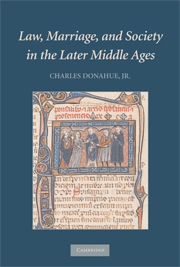Book contents
- Frontmatter
- Contents
- List of Tables
- List of Appendices
- Preface
- Acknowledgments
- Notes About This Book
- Introduction
- 1 The Background Rules and Institutions
- 2 Lying Witnesses and Social Reality: Four English Marriage Cases in the High Middle Ages
- 3 Statistics: The Court of York, 1300–1500
- 4 Story-Patterns in the Court of York in the Fourteenth Century
- 5 Story-Patterns in the Court of York in the Fifteenth Century
- 6 Ely
- 7 Paris
- 8 Cambrai and Brussels: The Courts and the Numbers
- 9 Cambrai and Brussels: The Content of the Sentences
- 10 Divorce a mensa et thoro and salvo iure thori (Separation)
- 11 Social Practice, Formal Rule, and the Medieval Canon Law of Incest
- 12 Broader Comparisons
- Epilogue and Conclusion
- Bibliography and Abbreviations
- Subject Index
- Texts and Commentary
- Table of Cases
- Table of Authorities
- Index of Persons and Places
1 - The Background Rules and Institutions
Published online by Cambridge University Press: 14 July 2009
- Frontmatter
- Contents
- List of Tables
- List of Appendices
- Preface
- Acknowledgments
- Notes About This Book
- Introduction
- 1 The Background Rules and Institutions
- 2 Lying Witnesses and Social Reality: Four English Marriage Cases in the High Middle Ages
- 3 Statistics: The Court of York, 1300–1500
- 4 Story-Patterns in the Court of York in the Fourteenth Century
- 5 Story-Patterns in the Court of York in the Fifteenth Century
- 6 Ely
- 7 Paris
- 8 Cambrai and Brussels: The Courts and the Numbers
- 9 Cambrai and Brussels: The Content of the Sentences
- 10 Divorce a mensa et thoro and salvo iure thori (Separation)
- 11 Social Practice, Formal Rule, and the Medieval Canon Law of Incest
- 12 Broader Comparisons
- Epilogue and Conclusion
- Bibliography and Abbreviations
- Subject Index
- Texts and Commentary
- Table of Cases
- Table of Authorities
- Index of Persons and Places
Summary
As we have said, the law of marriage of Western Europe of the Middle Ages was canon law, and it was complicated. By the beginning of the thirteenth century, the period in which we first have records of runs of cases, it was the product of a continuous development of more than seven hundred years, with roots going back into Roman law, Judaism, and early Christianity, and the customs of the non-Roman peoples of the West. A particularly notable feature of this development was the extraordinary efflorescence of learning, teaching, and promulgating law that occurred in the twelfth century. As we have also said, the story of this development is the topic for another book. Here we must briefly outline the rules as they existed, or were thought to exist, in the early years of the thirteenth century. While the next three centuries saw some development of these rules, perhaps more than is normally thought to have occurred, the changes were subtle and, with the notable exception of developments in the law of separation with which we have occasion to deal in Chapter 10, they do not seem to have had much effect on marriage litigation in ecclesiastical courts, the focus of this book. Hence, the outline that we give here may be taken as the outline of the rules that the proctors, advocates, and judges of the courts with which we are dealing assumed, or should have assumed, as they presented and decided the cases that were brought to them.
- Type
- Chapter
- Information
- Law, Marriage, and Society in the Later Middle AgesArguments about Marriage in Five Courts, pp. 14 - 45Publisher: Cambridge University PressPrint publication year: 2008



